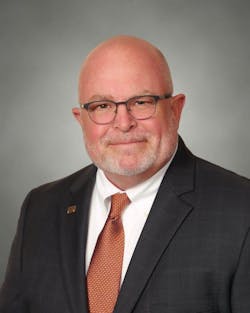Assess and Operate
By Steven J. Cyra, Contributing Author
The application of transportation systems management and operations (TSM&O) has become a core function of the nation’s departments of transportation because it is critical to the safe and efficient operations of our roadways.
While TSM&O has become more mainstream over the past decade or so, it is continually evolving and therefore must be systematically implemented.
TSM&O is a cross-cutting approach to optimizing existing roadway infrastructure through enhanced integration, coordination, and systematic implementation of operational strategies.
It is important to follow a structured process for considering and integrating TSM&O strategies. For new or major roadway reconstruction projects, this begins at the earliest project planning stages and progresses through construction and ongoing operations.
Specifically, construction or work zones present a host of operational challenges and are generally one of the leading causes of non-recurring congestion and negative safety impacts on our roadways.
For example, as the Wisconsin Department of Transportation embarked on the reconstruction of the interstate and interchanges in southeastern Wisconsin, they systematically incorporated TSM&O strategies in their comprehensive work zone transportation management plans to mitigate impacts.
By design, many of the TSM&O strategies, such as signal timing modifications and expanded devices tied to the department’s traffic management center, remain in place to facilitate ongoing optimized roadway operations.
DOTs in Florida and Iowa, for example, have been integrating TSM&O strategies into their processes, with Florida establishing its own TSM&O division dedicated for that purpose. In addition, each have also developed TSM&O strategic plans to map out a game plan, so their strategies are a component of any new project.
Ideally, DOTs would consider strategically structuring themselves in a likewise manner that automatically enables a TSM&O development process whenever roadway safety and mobility enhancement projects are considered.
Fortunately, there are tools and guidance available for those transportation organizations wishing to assess their ability to implement TSM&O. The TSM&O capability maturity model, developed through funding from the second Strategic Highway Research Program (SHRP2) and contributions from the American Association of Highway and Transportation Officials (AASHTO) and the Federal Highway Administration (FHWA) enables agencies to look inward at their business processes, systems and technology, performance measurement, workforce, culture, and collaboration.
From there, they can assess where they are, then identify and improve any deficient areas, all with the goal of enhancing surface transportation through TSM&O.
In the end, it’s imperative that an adequate foundational structure is put in place and that buy-in is obtained at the leadership level. By doing so, agencies will be better able to mainstream TSM&O into their processes.
Leveraging technology for the right reasons
A TSM&O plan identifies and addresses real-world problems and needs. Therefore, DOTs will want to identify the problems first, then consider a variety of solutions that include answers through the means of technology and more traditional approaches.
There is no need to deploy technology for the sake of deploying it. If an agency invests in an adaptive signal system, they may find that it was unnecessarily complex and difficult to operate and maintain compared to more simply re-timing or updating existing signal systems based on current traffic volumes.
The most effective solution might not require a significant capital expenditure at all. One example is the foundational TSM&O strategy of traffic incident management (TIM). An agency might consider the creation of a cross-functional group comprised of first responders including law enforcement, fire/EMS, towing and recovery, and transportation agencies to develop a sustained, ongoing TIM improvement program whereby responders all sit at the same table collaboratively working to identify, implement, or enhance improvement strategies, many of which come from the TSM&O toolbox.
Other key components of the TIM program TSM&O strategy involve responder training and after-action reviews. Through the leadership of FHWA, the National TIM Responder Training Program is responsible for training more than 600,000 first responders on safely and efficiently managing roadway traffic incidents.
After-action reviews are another relatively low-cost TIM activity that enable responders to assess their respective TIM actions and identify lessons learned and opportunities for improvement.
Of course, technology-based solutions also can be effective for TMS&O when properly applied, and for the right reasons. By performing a multi-year forecast, DOTs can stay ahead of the game by determining what technologies might be on the horizon – such as the use of connected vehicles on highways – then deploying prerequisite technologies to help them prepare for full implementation down the road.
Implement, then measure
It is critical to continually assess or measure the solutions’ effectiveness. While anecdotal evidence can be valuable, there is no substitute for collecting hard data on before-and after-strategy implementation conditions and analyzing to quantify benefits. Many technology-based TSM&O strategies can also support data collection to assess effectiveness.
Also, the performance assessment is important when considering that a solution that works well for one agency or situation may not necessarily yield the same success for another.
Few, if any, TSM&O strategies, particularly those involving technology, should be considered a “set-it and forget-it” solution. As part of the sustained problem-solving process, a deliberate, cyclic approach to planning, implementing and assessing is critical to ensuring that the strategy is indeed solving a problem and meeting the needs of the traveling public.
In the end, having an effective overall TSM&O strategy is critical for those agencies responsible for transportation operations. By carefully understanding the problem to be solved, initiating a structured TSM&O solution development process, implementing and assessing benefits, DOTs and other transportation agencies will be well-positioned for future success that cost-effectively optimizes our transportation infrastructure and keeps the traveling public safe. R&B
Steven Cyra, PE, PTOE, is a national practice consultant for HNTB, focusing on transportation systems management and operations.
